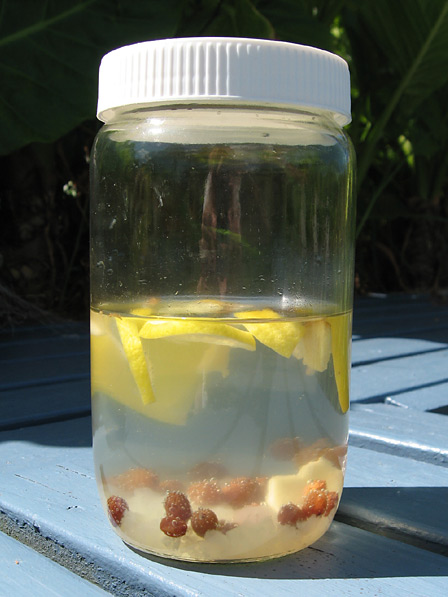Update: Order water kefir grains and all of Becky’s other cultures at waterkefir.co.nz.
Here’s some information about keeping and using water kefir grains. I feel that I’m still learning about how best to care for this culture, so this information is a work in progress. Still, after four months, our grains are continuing to increase by well over 100% every two days, so I suppose I must be doing something right. I’d be really interested to hear about the experiences and ideas of others who are keeping water kefir.
Basic Water Kefir Recipe:
6 Tablespoons water kefir grains
4 Tablespoons sugar
3 Cups water
½ lemon or a piece of lemon (if you can’t find an organic lemon, then take the skin off first)
A dried fig, or a tablespoon of raisins
(Optional: add 2-4 teaspoons of fresh ginger root juice to make a refreshing ginger beer kefir. To make the ginger root juice, pound or chop finely about 60g fresh ginger root and blend it to a mash with half a cup of water. Strain through a cloth, squeezing out the juice. You can also use dried ginger powder. Boil 1-2 tablespoons of ginger powder with 1 cup of water and then strain through a fine cloth. Cool this liquid before adding it to your brew. When brewing with ginger, you can leave out the raisins. The grains do really well when cultured with ginger!)
 Water kefir
Water kefir
I make this quantity of kefir in a 1 quart (1 litre) glass preserving jar. Whatever jar you use, please make sure you leave an inch or so at the top to accommodate the carbon dioxide gas produced by the fermentation process and avoid explosions! As your kefir grains reproduce themselves, you will need to adjust the ratios of ingredients for a bigger batch, or make more batches.
Method:
*Strain and rinse the grains under clean running water.
*Put them in the jar with the other ingredients, and stir until the sugar dissolves.
*Close the jar with a good firm lid, and leave it at room temperature to ferment. Stir after 24 hours, and as often as you like.
*Brew until the raisins float to the surface and the liquid is a bit fizzy. This might take about 48 hours, but could be a good deal faster when the weather is warm.
*Scoop the lemons and raisins off the top of the liquid.
*Now use a strainer to separate the water kefir grains from the liquid. Rinse the kefir grains thoroughly under cold water.
*Squeeze the lemon into the liquid and put it into tightly sealed bottles or jars. You can chill and drink the beverage now, if you wish. Or, to make it more fizzy, you can leave it to ferment (secondary fermentation) for another day or so at room temperature, before moving it to the fridge to chill for drinking. (Further fermentation will increase the alcohol content of the drink, depending on the amount of sugar in the liquid. In any case, water kefir drinks seem to be only very mildly alcoholic – like home-made ginger beer.)
Other Tips:
*Once you have made your first batch of water kefir, you can rinse the grains and start the next batch immediately.
*If you don’t want to make another batch immediately, you can store the grains in the fridge in a sugar water solution (1Tablespoon of sugar to 1 Cup water) for up to 7 days. You can also freeze strained, rinsed water kefir grains in plastic ziploc bags for up to 2-3 months.
*Sugar: Apparently the grains do best on less-refined, more mineral-rich sugars, though any kind of cane sugar will do (refined white sugar, golden sugar, muscovado, rapadura).
*Water: The grains do best in hard, highly mineralised water. If you are using soft or distilled water, add ¼ teaspoon of baking soda per 6 cups of water to keep the grains healthy. You can also add a piece of limestone, some boiled egg shell or a tiny pinch of calcium carbonate powder to the brewing water.
*Fermentation time: One of the main reasons why water kefir grains become sick and stop propagating is over-fermentation. In general, they should be brewed no longer than 2 days, though they may need 3 days in colder conditions. During the summer, daily brews might be needed to prevent over-fermentation. A brew is ready for straining when the raisins are floating to the top, and the liquid has become slightly fizzy and a little sour.
*Most of the information I’ve seen says to keep the kefir in glass containers.
*Wash water kefir containers and implements by hand using mild detergent, and rinse thoroughly.
*Always keep a batch of water kefir grains brewing with the basic recipe (or the ginger beer recipe) above. Please use only your extra grains for other recipes, since some ingredients (honey and herbs, for example) may cause the grains to lose their vigour and stop growing.
*Healthy fast-growing water kefir grains produce a brew with less alcohol and more health-giving probiotic properties than sluggish, sick grains.
*Use spare water kefir grains to make experimental brews using honey, herbs, or fruit juices. You can also try adding these other ingredients to the brew for the secondary fermentation.



